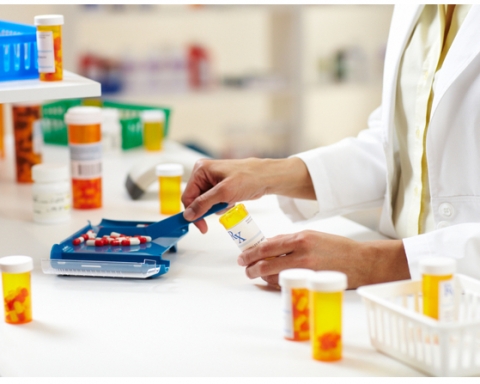Tablets may be defined as the solid unit dosage form of medicament or medicaments with or without suitable diluents and prepared either by molding or by compression. They vary greatly in shape, size, and weight which depend upon the amount of medicament and the mode of administration. Most commonly the tablets are disk-shaped with, convex surface, but they are also available in special shapes like round, oval, oblong, cylindrical, square, triangular, etc. They vary greatly in weight the tablets for oral administration may weigh from 0.2 to 0.8 gm including the diluents but the tablets meant for administration other than oral route may be lighter or heavier.
Classification of Tablet:
l. Oral tablets 2. Chewable tablets 3. Buccal/Sublingual tablets 4. Lozenge tablets 5. Soluble tablets 6. Effervescent tablets 7. Implants 8. Vaginal tablets (Inserts) 9. Enteric-coated tablets 10. Sustained action tablets 11. Sugar-coated tablets 12. Film-coated tablets 13. Layered tablets. 14. Press coated tablets.
Molded Tablets
1. Hypodermic tablets. 2. Dispensing tablets.
- Oral Tablets These tablets are swallowed as such. They are placed over the tongue and swallowed with a drink of water or any other suitable liquid.
- Chewable Tablets These tablets are given to the children who have difficulty in Swallowing and to the adults who dislike swallowing. A number of antacid tablets and multivitamin tablets are prepared as chewable tablets.
- Buccal /Sublingual Tablets These tablets are required to be placed below the tongue (sublingual) or in the side of the cheek (buccal) for the slow release of the medicament except in the case of nitroglycerin and mannitol Hexa nitrate tablets which should dissolve in 1 to 2 minutes to produce an immediate effect.
- Lozenge Tablets This tablet should not disintegrate in the oral cavity but should dissolve slowly in the mouth to produce a continuous effect on the mucous membrane of the throat. They can be prepared by molding as well as by the compression method. The lozenges prepared by compression are known as lozenges tablets.
- Soluble Tablets These tablets are required to dissolve completely in the liquid to produce a solution of definite concentration. The solutions prepared by dissolving the soluble tablets may include mouthwashes, gargles, skin lotions, douches, antibiotics, and certain vitamins. The use of soluble tablets, ‘hypodermic tablets’ for the preparation of injectable solutions is restricted because the solutions so prepared are not sterile.
- Effervescent Tablets These tablets along with the active medicament contain other ingredients like sodium bicarbonate, citric acid, and tartaric acid which: act in the tile presence of water liberating carbon dioxide and producing effervescence leading to disintegration of the tablet, thus hastens solution formation and increases the palatability. These tablets have the advantage over effervescent powders in the tablet dosage form.
- Vaginal Tablets (Inserts) Sometimes vaginal suppositories or pessaries are prepared by compression winch are known as vaginal tablets. Antibiotics and steroids are formulated in this way. Soluble additives are used for tinier preparation. They are generally ovoid or almond-shaped for ease of insertion. Plastic tube inserters can also be used for placing these tablets in the vaginal tract.
- Implants Implants are small tablets meant for insertion under the skin by giving as small surgical cut into the skin which is stitched after the insertion of the tablet. Since these tablets are to be implanted intramuscularly or subcutaneously therefore they must be sterile. They must be prepared under aseptic conditions and packed in unit dose sterile containers. Implants are prepared to provide a slow and continuous release of the drug over prolonged periods of time ranging from 3 months to b months or even more. Due to this reason the drugs used in the preparation of implants are water-insoluble, no excipients are used and they are compressed under heavy pressure. These tablets are more commonly used in veterinary medicine than human medicine. They can also be used for birth control in human beings. Generally steroidal hormones like testosterone, stilbesterol, etc. are formulated as implants.
- Enteric Coated Tablets These are the tablets which are disintegrated in the intestines and not in the stomach. They are given coating which makes the tablet to pass the stomach as such but breaks in the alkaline medium of the intestines.
- Sustained Action Tablets These are the tablets which after oral administration release the drug at the desired time and prolong the effect of the medicament. Repeat action tablets are used to periodically release a complete dose of the drug to the G.LT. fluids thus maintaining a constant blood concentration.
- Sugar Coated Tablets These are the compressed tablets which are given a sugar coating to mask the object able taste and odor of the drug as well as to protect the substances from atmospheric conditions. To make elegant they can be given a suitable color coating.
- Film-Coated Tablets These are the compressed tablets that are given a thin coating of water-soluble materials that protect the drug substance form atmospheric conditions. Various polymers are used for film coating.
- Layered Tablets
These are the compressed tablets in which the granules of incompatible substances are compressed into two or more layers successively in the same tablet. Special tablet making machines are required for making layered tablets.
Advantages
Of the two oral solid dosage forms commonly employed in this country, the tablet and the capsule, the tablet has a number of advantages.
1. They are a unit dose form, and they offer the greatest capabilities of all oral dosage forms for the greatest dose precision and the least content variability
2. Their cost is the lowest of all oral dosage forms.
3. They are the lightest and most compact of all oral ~dosage forms.
4. They are in general the easiest and cheapest to package and ship of all oral dosage forms.
5. Product identification is potentially the simplest and cheapest, requiring no additional processing steps when employing an embossed or monogrammed punch face.
6. They may provide the greatest ease of swallowing with the least tendency for “hang-up” above the stomach, especially when coated, provided that tablet disintegration is not excessively rapid.
7. They lend themselves to certain special release profile products, such as enteric or delayed-release products.
8. They are better suited to large-scale production ~than other unit oral forms.
9. There has the best-combined properties of chemicals, mechanical and microbiologic stability of all the oral forms.
Disadvantages
The disadvantages of tablets include the following
1. Some drugs resist compression into dense compacts, owing to their amorphous nature or flocculent, low-density character.
2. Drugs with poor wetting, slow dissolution properties, intermediate to large dosages, optimum absorption high in the gastrointestinal tract, or any combination of these features may be difficult or impossible to formulate and manufacture as a tablet that will still provide adequate or full drug bioavailability.
3. Bitter-tasting drugs, drugs with an objectionable odor, or drugs that are sensitive to oxygen or atmospheric moisture may require encapsulation or entrapment prior to compression
4. Coating, in such cases capsule is the lowest cost approach
Evaluation of Tablets or Standardization of Tablets
The following standards or quality control tests are carried out on compressed tablets:
l. Diameter size and shape.
2. Uniformity of weight.
3. Thickness.
4. Hardness.
5. Friability.
6. Percentage of medicament.
7. Rate of disintegration.
l. Diameter size and shape
The diameter size and shape of tablets depends on the die and punches selected for making the tablets. The tablets of various sizes and shapes are prepared but generally they are circular with either flat or biconvex faces.
2. Uniformity of weight
It is desirable that all the tablets of a particular batch should be uniform in weight. If any weight variation is there, that should fall within the prescribed limits (generally 10% for tablets weighing 120 mg. or less, 7.5% for tablets weighing 120 mg to 300 mg and 5% for tablets weighing more than 300 mg). The test is considered correct if not more than two tablets fall outside this range if 20 tablets are taken for the test and not more than one tablet falls outside this range if only ten tablets are taken for the test.
3. Thickness
The thickness of a tablet can vary without any change in its weight. This is generally due to the difference in density of granules, the pressure applied for compression, and the speed of compression. The thickness of a tablet can be determined with the help of micrometer calipers. The thickness variation limits allowed are f5% of the size of the tablet. The variation in thickness leads to counting and packing problems.
4. Hardness
The hardness of the tablet depends on the weight of the material used, space between the upper and lower punches at the time of compression, and pressure applied during compression. The hardness also depends on the nature and quantity of excipients used during formulation.
If the finished tablet is too hard, it may not disintegrate in the required period of time and if the tablet is too soft it may not withstand the handling during packing and transporting. Therefore it is very necessary to check the hardness of tablets when they are being compressed and pressure adjusted accordingly on the tablet machine.
5. Friability
Friability test is performed to evaluate the ability of the tablets to withstand abrasion in packing; handling and transporting. The instrument used for this test is known as friability Test Apparatus’ or ‘Friabilater’. It consists of a plastic chamber that is divided into two parts and revolves at a speed of 25 r.p.m. A number of tablets are weighed and placed in the tumbling chamber which is rotated for four minutes or for 100 revolutions. During each revolution, the tablets fall from a distance of six inches to undergo shock. After 100 revolutions the tablets are again weighed and the loss in weight indicates the friability.
6. Percentage of Medicament
This test is performed to ensure that every tablet, coated or uncoated must contain the stated amount of medicaments within the prescribed limits. A number of tablets from a batch are selected at random and assay procedures are carried out according to the monographs given in the official books. The results obtained must be within the prescribed percentage limits.
7. Rate of Disintegration
The disintegration test is performed to find out that within how much time the tablet disintegrates. This test is very important and necessary for all the tablets, coated or uncoated to be swallowed because the dissolution rate depends upon the time of disintegration which ultimately affects the rate of absorption of drugs.
8. Dissolution Test
The rate of dissolution of a solid drug plays, an important role in the absorption and physiological availability of the drug in the bloodstream. Therefore determination of the dissolution rate of any solid drug is very necessary. For this purpose, there are a number of tests available in the literature but none is official. This test is performed for tablets and capsules when stated in the individual drug monograph.
Tablet manufacturing process
Tablets are solid masses made by compaction of suitably prepared medicaments by means of a tablet machine. It is the most widely used dosage form. Either wet granulation or dry compression usually produces them.
Unit of tablet section:
Dispensing unit
Granulation unit
Compression unit
Coating unit
Dispensing unit:
The dispensing unit receive the required raw materials that are approved by QC for tablet preparation. It supplies materials to the granulation and coating unit after accurate weighing according to the dispensing order sheet and returns the remaining materials to the store.
Granulation unit:
Granulation is the process in which the powder particles of raw materials are made to form larger particles in order to facilities compression for the production of tablet. All the materials received from dispensing unit and granulation is performed.
Wet granulation:
This is the most widely used and most general method of tablet preparation. The wet granulation of tablet production is essentially a process of size enlargement, sticking particles of drug and excipients together using an adhesive to produce a granular product with improved flow properties and increased ability to cohere under pressure.
Dry granulation:
This process is applied for those drugs which are sensitive to moisture. This process is also used for water sensitive powder that needs granule formation before compression.
Direct compression:
Tablets are produced directly from the powder by compression without modifying the physical nature. It is done for only few selective drugs, which has crystalline nature.
Condition for manufacturing of Granules:
- Relative Humidity: Not more than 55%.
- Temperature: Below 250C.
Coming up next: Tablet Compression and Coating with illustrations. Stay connected and tell about us to your friends and folks.
[Source: Pharmacy Review for Dummies by Md. Mehedi Faysal, Senior Quality Control Officer – Eskayef Bangladesh Limited]
[You will get all contents of this book only on PharmaMirror.com and obviously with prior permission from the author]








